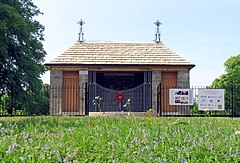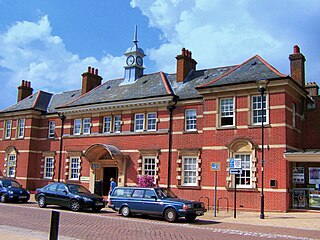
Eastleigh is a town in Hampshire, England, between Southampton and Winchester. It is the largest town and the administrative seat of the Borough of Eastleigh, with a population of 24,011 at the 2011 census.

Chilworth is a village in the Test Valley district of Hampshire, England, on the northern edge of Southampton. Good travel connections and restricted development have led to the village becoming particularly affluent. The village was referred to as Celeworda in the Domesday Book of 1086, and is now in two parts: modern Chilworth lying along the straight 'new' stretch of the Southampton to Romsey road, and old Chilworth built around the 'old' road.
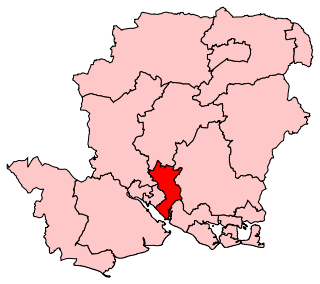
Eastleigh is a constituency represented in the House of Commons of the UK Parliament since 2019 by Paul Holmes, a Conservative.

Swaythling is a suburb and electoral ward of the city of Southampton in Hampshire, England. The ward has a population of 13,664.
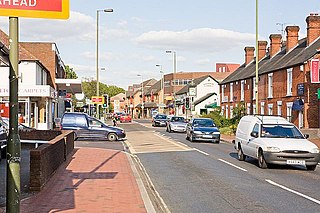
Chandler's Ford is a largely residential area and civil parish in the Borough of Eastleigh in Hampshire, England. It has a population of 21,436 in the 2011 Census.

Portswood is a suburb and Electoral Ward of Southampton, England. The suburb lies to the north-north-east of the city centre and is bounded by Freemantle, Highfield, Swaythling, St. Denys and Bevois Valley.

North Baddesley is a large village and civil parish in Hampshire, England. It is situated 3 mi (5 km) east of the town of Romsey and 6 mi (10 km) north of Southampton. It occupies an area of approximately 9.15 km2 (3.53 sq mi), and is home to a population of just over 10,000 people, reducing to 7,000 at the 2011 Census. It is located in the Test Valley; a river famous for trout fishing.

West End is a parish in Hampshire in the borough of Eastleigh, five miles (8.0 km) east of the city of Southampton. The village of West End is small and generally classed as an area in the outer suburbs or rural urban fringe of the borough of Eastleigh because of the surrounding woodland and countryside, including Telegraph Woods and Itchen Valley Country Park.

Monks Brook is a river in the English county of Hampshire. It is a tributary of the River Itchen, which it joins at a medieval salmon pool in Swaythling. The brook is formed from seven streams that rise in the chalky South Downs, with the official source of Monks Brook being known as Bucket's Corner. Monks Brook drains a clay catchment of 49 square kilometres (19 sq mi). The brook is designated a main river, which means the operating authority for managing it is the Environment Agency, not the local government authorities for the areas through which the river runs.

Bassett is a suburb and electoral ward of the City of Southampton, England. The suburb lies to the north of the city centre and is largely residential, including the University of Southampton's Glen Eyre Halls of residence complex, which houses around 2,100 students. Bassett gives its name to part of the A33 arterial road which links the city centre to the M3, described by Pevsner & Lloyd as "part of the splendid tree-lined route into Southampton from Winchester, London and the north". The highest point in the City of Southampton lies on Bassett Avenue at a height of 82 metres (269 ft) above sea level.

Bassett Green is a suburb of Southampton, which has grown from the original small village of Basset. It remains part of the electoral ward of Bassett. The area is mainly residential, with a mixture of Herbert Collins-designed houses and council built estates known as the Flowers Estate and the Leaside Way Estate. Within Bassett Green are a community centre, Bassett Green Primary School and Southampton Crematorium, as well as several of the University of Southampton's halls of residence.
John Willis Fleming was an English landed proprietor and Conservative Member of Parliament.

South Stoneham House is a Grade II* listed former manor house in Swaythling, Southampton; the former seat of the Barons Swaythling before the family moved to the nearby Townhill Park House. The building is owned by the University of Southampton, and was used as a hall of residence, part of the Wessex Lane Halls complex.
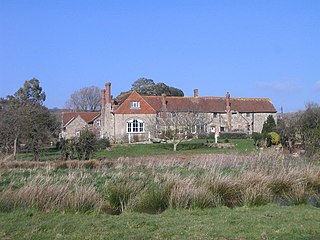
Haseley Manor is a 14th-century, Grade 2* listed property located in Arreton on the Isle of Wight.
South Stoneham was a manor in South Stoneham parish. It was also a hundred, Poor law union, sanitary district then rural district covering a larger area of south Hampshire, England close to Southampton.

St. Mary's Church, South Stoneham is one of the two remaining medieval churches in the city of Southampton, England. Parts of the building date from the Norman period and the chancel arch is 12th century. The church lies in a secluded position off Wessex Lane, near the north-eastern edge of Southampton and is almost hidden in the Southampton University accommodation campus.

St. Nicolas Church is an Anglican parish church at North Stoneham, Hampshire which originated before the 15th century and is known for its "One Hand Clock" which dates from the early 17th century, and also for various memorials to the famous.

St. Michael and All Angels Church, in Bassett, Southampton, is an Anglican parish church which dates from the late 19th century.

North Stoneham Park, also known as Stoneham Park, was a landscaped parkland and country house of the same name, north of Southampton at North Stoneham, Hampshire. It was the seat of the Fleming family. The park was remodelled by Lancelot Brown in the 18th century. It is listed in the Hampshire Register of Historic Parks and Gardens.
Shamblehurst, also known as Sandhust, was a manor and tithing within the ancient parish of South Stoneham, now in the modern-day Borough of Eastleigh. It had Allington tithing to the north and Botley and Durley parishes to the east.
